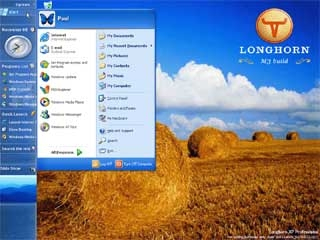Windows 6.0/Longhorn: an early look

Integrated Palladium security system
Microsoft's biggest and most contentious innovation of all is the integration of a new security system called Palladium. This is a real-time module that requires special hardware in order to operate separately from other system components. The new security standards will involve both software developers and chip manufacturers such as Intel and AMD.
During the boot-up process, the BIOS will check the hardware and then identify the PC's users/owners. The aim is to protect the system as well as the data against unauthorised access, and also to prevent attacks from the Internet. Data is encrypted on the hard disk and special control checks are made on data going out to the Internet or the company network. Palladium examines all the connections and identifies the receivers in the network. This verification process controls which data arriving over the Internet will make it all the way to the PC, and determines whether the data has been certified for usage. This also means there will be more opportunities to block hackers trying to penetrate a foreign system. Unwanted email, or spam, will finally be prevented from entering the system just as successfully as viruses or worms.
Document integrity will ensure that the owner of the data will know about previous authors, and the full extent of any changes that have been made. It will also be possible to attach a timestamp to a Word document, for example, that allows the data to be read only up to a certain date. Email can also be addressed in such a way that it reaches only the addressee and cannot be copied or forwarded on to a third party.
This feature comes from the Digital Right Managements (DRM) idea, which was originally conceived for the media industry. Audio, video or other copyright-protected material will therefore be transferable exclusively to the entitled receiver.
But all of these Palladium features lead to one problem, which is downplayed by its developers: once identified by Palladium, users reveal each and every one of their activities. Microsoft has built this feature mainly with IT administrators, decision makers and the average user in mind. Although US-based users might demand, or tolerate, intensified Internet security following 11 September 2001, Microsoft is likely to be faced with different data security guidelines at an international level. Palladium-based PCs can also run with conventional operating systems and applications: if an application is Palladium-compliant, it can be activated accordingly. In this respect, it is similar to the .NET model, in that managed and non-managed code can coexist.
Criticism has been particularly loud from associations accusing Bill Gates's Trustworthy Computing initiative of 'Controlled Computing'. According to critics, Microsoft's monopolistic position could lead to a future where even the most basic action performed on a PC will require a licence from the software giant.
The demand for Palladium comes from organisations for whom improved data security is paramount. With this initiative, Microsoft will have a clear advantage in its dominance over other operating systems -- although, according to Microsoft, Palladium will not remain a pure Windows application: Linux and Mac implementations are allegedly in the works.
Launch date
The launch date for Longhorn is not yet known. Originally scheduled for 2003-2004, it is now more likely to be 2005. Microsoft has had to change its plans and alter its roadmap several times. The release of Windows 6.0 Server should follow shortly after Longhorn, under the codename Blackcomb.
When will Blackcomb ship? Looking back at the additional service packs that followed Windows .NET Server, Blackcomb is likely to be a while yet -- after all, corporate users need to have these OS updates implemented on their servers gradually. Licensing aspects will also determine the next steps for a server solution.
Because the release of the server version must follow the desktop version in a definable time frame, it's possible that the launch date for Longhorn could be delayed as long as early 2006.
Conclusion
Windows 6.0/Longhorn will represent a new milestone in operating systems and Microsoft's bumpy roadmap. The planned rebuild of the PC's architecure from the ground up is in any case a welcome initiative, to which Microsoft has contributed a lot. It remains to be seen to what extent the 'Bill factor' will affect the final result.

Start screen: new elements such as the clock and see-through menus supplement the start display.
A lot of new multimedia features and a search window too.
The Longhorn version of the XP start menu.
Clearly recognisable: the licence details for individual audio files.
Sidebar: in the alpha version, this can be enabled or disabled from the start menu.
Changing the display properties: incomplete but still comprehensible.
Not quite error free: setting up the desktop display.